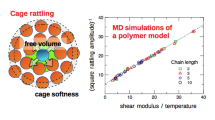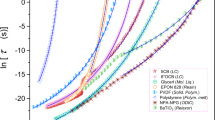Abstract
It is often said that the fragility and specific heat discontinuity at the glass transition are related characteristic features of glasses. We give a relation between these quantities for simple liquids, and also find that the temperature dependence of the shear modulus should be closely related to these quantities. According to the Interstitialcy Theory, the liquid state shear modulus G = Go, exp (-βc) = Go exp {-γ[(T/To)-l ]}, where Gois the shear modulus at a reference temperature To, which can be taken to be the glass temperature. In these relations, βis the diaelastic shear susceptibility, c is the interstitialcy concentration, T is the temperature, and dc/dT = γ/βTo. It has been proposed by Dyre, Olsen and Christensen that U in the viscosity η = ηo exp (U/kT) be given as the work done in shoving aside particles during a diffusion step, and therefore be proportional to the (liquid state) shear modulus. If so, then combining the above relations, the fragility F = [d log η/d (Tg/T]T=Tg becomes F=(1+γ) log [η (Tg)/ηo], where γ = - (Tg/G)(dG/dT). Then, since δCv, = UF(dc/dT), where UF is the interstitialcy formation energy, one obtains further with reasonable simplifying approximations δCv/Cv~γG(T)/Goo, where Goo is the zero temperature crystalline shear modulus. For a typical fragile glass γ ~ 2 (F ~ 50) with G(Tg)/Goo ~ 1/2, then δCv/Cv, ~ 1, ut close to zero for strong glasses, in fair agreement with available experimental results. The perspective given by the Interstititialcy Theory is then that the fragility is given phenomenologically by the temperature dependence of the shear modulus, or microscopically by the rate of increase of the equilibrium interstitialcy concentration with temperature.
Similar content being viewed by others
References
C.A. Angell, in Relaxation in Complex Systems, K. Ngai and G.B. Wight, Eds. (National Technical Information Service, U.S. Department of Commerce, Springfield, VA, 1985) p. 1–11.
A.V. Granato, Phys. Rev. Lett. 68, p. 974–977, (1992).
A.V. Granato, Met. and Mat. Trans. A, 29A, p. 1837–1843 (1998).
J.E. Dyre, N.B. Olsen and T. Christensen, Phys. Rev. B53, p. 2171 (1996).
D.M. Zhu and H. Chen, J. Non-Cryst. Sol., 224, p. 97–101 (1998).
D.J. Plazek and K.L. Ngai, Macromolecular 24, p. 1222 (1991).
R. Bohmer, K.L. Ngai, C.A. Angell and D.J. Plazek, J. Chem. Phys. 99, p. 4201–4209 (1993).
A.J. Barlow, J. Lamb, A.J. Matheson, P.R.K.L. Padmini, and J. Richter, Proc. Roy. Soc. London Ser. 1298, pp. 467–480 (1967).
Author information
Authors and Affiliations
Corresponding author
Rights and permissions
About this article
Cite this article
Granato, A.V. A Relation Between Fragility, Specific Heat, and Shear Modulus Temperature Dependence for Simple Supercooled Liquids. MRS Online Proceedings Library 554, 299–303 (1998). https://doi.org/10.1557/PROC-554-299
Published:
Issue Date:
DOI: https://doi.org/10.1557/PROC-554-299




